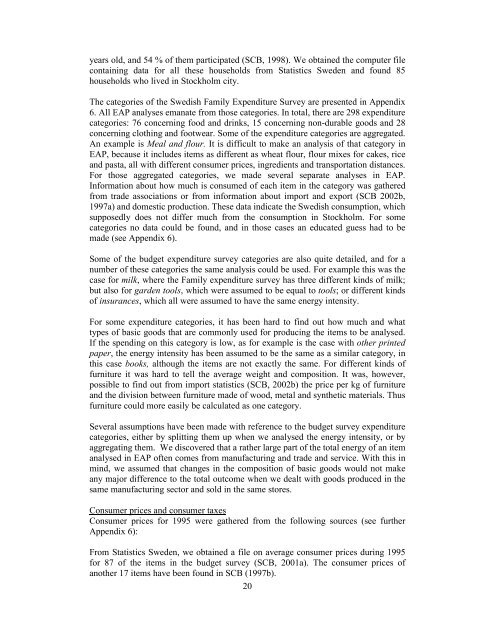Household Metabolism in the Five Cities.
Household Metabolism in the Five Cities.
Household Metabolism in the Five Cities.
Create successful ePaper yourself
Turn your PDF publications into a flip-book with our unique Google optimized e-Paper software.
years old, and 54 % of <strong>the</strong>m participated (SCB, 1998). We obta<strong>in</strong>ed <strong>the</strong> computer file<br />
conta<strong>in</strong><strong>in</strong>g data for all <strong>the</strong>se households from Statistics Sweden and found 85<br />
households who lived <strong>in</strong> Stockholm city.<br />
The categories of <strong>the</strong> Swedish Family Expenditure Survey are presented <strong>in</strong> Appendix<br />
6. All EAP analyses emanate from those categories. In total, <strong>the</strong>re are 298 expenditure<br />
categories: 76 concern<strong>in</strong>g food and dr<strong>in</strong>ks, 15 concern<strong>in</strong>g non-durable goods and 28<br />
concern<strong>in</strong>g cloth<strong>in</strong>g and footwear. Some of <strong>the</strong> expenditure categories are aggregated.<br />
An example is Meal and flour. It is difficult to make an analysis of that category <strong>in</strong><br />
EAP, because it <strong>in</strong>cludes items as different as wheat flour, flour mixes for cakes, rice<br />
and pasta, all with different consumer prices, <strong>in</strong>gredients and transportation distances.<br />
For those aggregated categories, we made several separate analyses <strong>in</strong> EAP.<br />
Information about how much is consumed of each item <strong>in</strong> <strong>the</strong> category was ga<strong>the</strong>red<br />
from trade associations or from <strong>in</strong>formation about import and export (SCB 2002b,<br />
1997a) and domestic production. These data <strong>in</strong>dicate <strong>the</strong> Swedish consumption, which<br />
supposedly does not differ much from <strong>the</strong> consumption <strong>in</strong> Stockholm. For some<br />
categories no data could be found, and <strong>in</strong> those cases an educated guess had to be<br />
made (see Appendix 6).<br />
Some of <strong>the</strong> budget expenditure survey categories are also quite detailed, and for a<br />
number of <strong>the</strong>se categories <strong>the</strong> same analysis could be used. For example this was <strong>the</strong><br />
case for milk, where <strong>the</strong> Family expenditure survey has three different k<strong>in</strong>ds of milk;<br />
but also for garden tools, which were assumed to be equal to tools; or different k<strong>in</strong>ds<br />
of <strong>in</strong>surances, which all were assumed to have <strong>the</strong> same energy <strong>in</strong>tensity.<br />
For some expenditure categories, it has been hard to f<strong>in</strong>d out how much and what<br />
types of basic goods that are commonly used for produc<strong>in</strong>g <strong>the</strong> items to be analysed.<br />
If <strong>the</strong> spend<strong>in</strong>g on this category is low, as for example is <strong>the</strong> case with o<strong>the</strong>r pr<strong>in</strong>ted<br />
paper, <strong>the</strong> energy <strong>in</strong>tensity has been assumed to be <strong>the</strong> same as a similar category, <strong>in</strong><br />
this case books, although <strong>the</strong> items are not exactly <strong>the</strong> same. For different k<strong>in</strong>ds of<br />
furniture it was hard to tell <strong>the</strong> average weight and composition. It was, however,<br />
possible to f<strong>in</strong>d out from import statistics (SCB, 2002b) <strong>the</strong> price per kg of furniture<br />
and <strong>the</strong> division between furniture made of wood, metal and syn<strong>the</strong>tic materials. Thus<br />
furniture could more easily be calculated as one category.<br />
Several assumptions have been made with reference to <strong>the</strong> budget survey expenditure<br />
categories, ei<strong>the</strong>r by splitt<strong>in</strong>g <strong>the</strong>m up when we analysed <strong>the</strong> energy <strong>in</strong>tensity, or by<br />
aggregat<strong>in</strong>g <strong>the</strong>m. We discovered that a ra<strong>the</strong>r large part of <strong>the</strong> total energy of an item<br />
analysed <strong>in</strong> EAP often comes from manufactur<strong>in</strong>g and trade and service. With this <strong>in</strong><br />
m<strong>in</strong>d, we assumed that changes <strong>in</strong> <strong>the</strong> composition of basic goods would not make<br />
any major difference to <strong>the</strong> total outcome when we dealt with goods produced <strong>in</strong> <strong>the</strong><br />
same manufactur<strong>in</strong>g sector and sold <strong>in</strong> <strong>the</strong> same stores.<br />
Consumer prices and consumer taxes<br />
Consumer prices for 1995 were ga<strong>the</strong>red from <strong>the</strong> follow<strong>in</strong>g sources (see fur<strong>the</strong>r<br />
Appendix 6):<br />
From Statistics Sweden, we obta<strong>in</strong>ed a file on average consumer prices dur<strong>in</strong>g 1995<br />
for 87 of <strong>the</strong> items <strong>in</strong> <strong>the</strong> budget survey (SCB, 2001a). The consumer prices of<br />
ano<strong>the</strong>r 17 items have been found <strong>in</strong> SCB (1997b).<br />
20
















